Genome-wide analysis of germ cell proliferation in C.elegans identifies VRK-1 as a key regulator of CEP-1/p53
- PMID: 20599896
- PMCID: PMC3375680
- DOI: 10.1016/j.ydbio.2010.06.022
Genome-wide analysis of germ cell proliferation in C.elegans identifies VRK-1 as a key regulator of CEP-1/p53
Abstract
Proliferating germ cells in Caenorhabditiselegans provide a useful model system for deciphering fundamental mechanisms underlying the balance between proliferation and differentiation. Using gene expression profiling, we identified approximately 200 genes upregulated in the proliferating germ cells of C. elegans. Functional characterization using RNA-mediated interference demonstrated that over forty of these factors are required for normal germline proliferation and development. Detailed analysis of two of these factors defined an important regulatory relationship controlling germ cell proliferation. We established that the kinase VRK-1 is required for normal germ cell proliferation, and that it acts in part to regulate CEP-1(p53) activity. Loss of cep-1 significantly rescued the proliferation defects of vrk-1 mutants. We suggest that VRK-1 prevents CEP-1 from triggering an inappropriate cell cycle arrest, thereby promoting germ cell proliferation. This finding reveals a previously unsuspected mechanism for negative regulation of p53 activity in germ cells to control proliferation.
Copyright 2010 Elsevier Inc. All rights reserved.
Figures
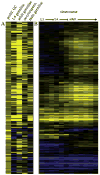

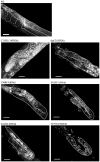
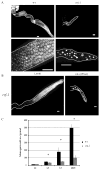





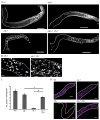
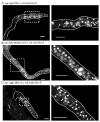

Similar articles
-
Regulation of Caenorhabditis elegans p53/CEP-1-dependent germ cell apoptosis by Ras/MAPK signaling.PLoS Genet. 2011 Aug;7(8):e1002238. doi: 10.1371/journal.pgen.1002238. Epub 2011 Aug 25. PLoS Genet. 2011. PMID: 21901106 Free PMC article.
-
The SCF FSN-1 ubiquitin ligase controls germline apoptosis through CEP-1/p53 in C. elegans.Cell Death Differ. 2008 Jun;15(6):1054-62. doi: 10.1038/cdd.2008.30. Epub 2008 Mar 14. Cell Death Differ. 2008. PMID: 18340346
-
Regulation of developmental rate and germ cell proliferation in Caenorhabditis elegans by the p53 gene network.Cell Death Differ. 2007 Apr;14(4):662-70. doi: 10.1038/sj.cdd.4402075. Epub 2006 Dec 22. Cell Death Differ. 2007. PMID: 17186023
-
The regulatory network controlling the proliferation-meiotic entry decision in the Caenorhabditis elegans germ line.Curr Top Dev Biol. 2006;76:185-215. doi: 10.1016/S0070-2153(06)76006-9. Curr Top Dev Biol. 2006. PMID: 17118267 Review.
-
The germline in C. elegans: origins, proliferation, and silencing.Int Rev Cytol. 2001;203:139-85. doi: 10.1016/s0074-7696(01)03006-6. Int Rev Cytol. 2001. PMID: 11131515 Review.
Cited by
-
3,3'-Diindolylmethane Supplementation Maintains Oocyte Quality by Reducing Oxidative Stress and CEP-1/p53-Mediated Regulation of Germ Cells in a Reproductively Aged Caenorhabditis elegans Model.Antioxidants (Basel). 2022 May 11;11(5):950. doi: 10.3390/antiox11050950. Antioxidants (Basel). 2022. PMID: 35624814 Free PMC article.
-
X Chromosome Crossover Formation and Genome Stability in Caenorhabditis elegans Are Independently Regulated by xnd-1.G3 (Bethesda). 2016 Dec 7;6(12):3913-3925. doi: 10.1534/g3.116.035725. G3 (Bethesda). 2016. PMID: 27678523 Free PMC article.
-
VRK-1 extends life span by activation of AMPK via phosphorylation.Sci Adv. 2020 Jul 1;6(27):eaaw7824. doi: 10.1126/sciadv.aaw7824. Print 2020 Jul. Sci Adv. 2020. PMID: 32937443 Free PMC article.
-
Regulation of miRNA abundance by RNA binding protein TOUGH in Arabidopsis.Proc Natl Acad Sci U S A. 2012 Jul 31;109(31):12817-21. doi: 10.1073/pnas.1204915109. Epub 2012 Jul 16. Proc Natl Acad Sci U S A. 2012. PMID: 22802657 Free PMC article.
-
Parent-of-Origin-Dependent Gene Expression in Male and Female Schistosome Parasites.Genome Biol Evol. 2018 Mar 1;10(3):840-856. doi: 10.1093/gbe/evy037. Genome Biol Evol. 2018. PMID: 29447366 Free PMC article.
References
-
- Aggarwal BD, Calvi BR. Chromatin regulates origin activity in Drosophila follicle cells. Nature. 2004;430:372–376. - PubMed
-
- Aladjem MI, Spike BT, Rodewald LW, Hope TJ, Klemm M, Jaenisch R, Wahl GM. ES cells do not activate p53-dependent stress responses and undergo p53-independent apoptosis in response to DNA damage. Curr Biol. 1998;8:145–155. - PubMed
-
- Berry LW, Westlund B, Schedl T. Germ-line tumor formation caused by activation of glp-1, a Caenorhabditis elegans member of the Notch family of receptors. Development. 1997;124:925–936. - PubMed
-
- Boehme KA, Blattner C. Regulation of p53–insights into a complex process. Crit Rev Biochem Mol Biol. 2009;44:367–392. - PubMed
-
- Bosl GJ, Motzer RJ. Testicular germ-cell cancer. N Engl J Med. 1997;337:242–253. - PubMed
Publication types
MeSH terms
Substances
Grants and funding
LinkOut - more resources
Full Text Sources
Molecular Biology Databases
Research Materials
Miscellaneous

